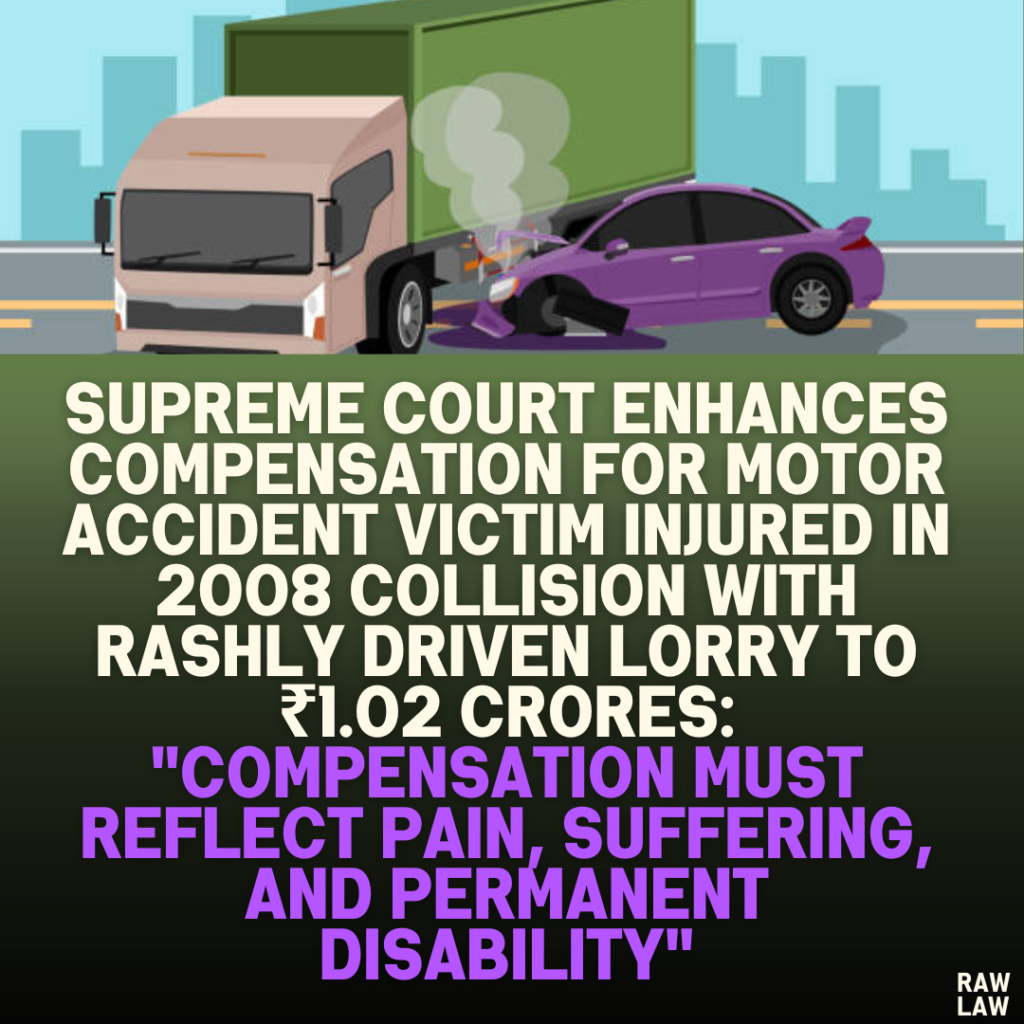Court’s Decision
The Supreme Court enhanced the compensation payable to the appellant to ₹1,02,29,241. The Court revised two key components:
- Future Prospects: Increased the addition for future income to 50% from 40%, in line with the guidelines laid out in the Constitution Bench judgment in Pranay Sethi.
- Pain and Suffering: Increased the compensation under this head to ₹15,00,000, acknowledging the severe and lifelong impact of the injuries suffered by the appellant.
The judgment emphasized the importance of calculating just compensation, which includes both pecuniary and non-pecuniary damages, based on the principle of restitutio ad integrum (restoration to original condition as far as possible).
Facts of the Case
- Incident: The appellant was injured in a motor vehicle accident on August 22, 2008, when a container lorry, driven rashly, collided with his vehicle.
- Injuries: The appellant sustained catastrophic injuries, including multiple fractures, leading to:
- 100% permanent disability.
- Complete paralysis below the neck, with no control over bowel and urinary functions.
- Total dependence on assistance for daily activities.
- Impact: The appellant, aged 37, was permanently wheelchair-bound and could no longer perform his duties as a Team Leader or engage in other employment, such as his work as a Life Insurance Corporation agent.
- Tribunal Award: Initially, the Tribunal awarded ₹58,09,930, factoring in the appellant’s gross monthly salary, permanent disability, and other compensatory heads.
- High Court Revision: On appeal, the High Court increased the compensation to ₹78,16,390 but limited the future prospects to 40% and maintained ₹1,00,000 for future medical expenses and ₹3,00,000 for pain and suffering.
Issues
- Whether the High Court erred in limiting future prospects to 40% instead of 50% for a permanent employee below the age of 40.
- Whether the compensation awarded under “pain and suffering” and “future medical expenses” was inadequate, given the appellant’s permanent and severe disability.
Petitioner’s Arguments
- The High Court erroneously applied a 40% addition for future prospects, which contradicted the guidelines established in Pranay Sethi, mandating a 50% addition for permanent employees below 40 years of age.
- The compensation awarded under the head “pain and suffering” was grossly inadequate, considering the appellant’s 100% functional disability, lifelong paralysis, and dependency. Reliance was placed on Kajal v. Jagdish Chand and Benson George v. Reliance General Insurance Co. to argue for ₹10,00,000 under this head.
- The award for future medical expenses was maintained by the High Court at ₹1,00,000 without adequate discussion or justification. It was argued this should also be enhanced.
Respondent’s Arguments
- The existing compensation, as calculated by the High Court, adequately addressed the appellant’s disabilities and suffering.
- The claim for a 50% addition for future prospects was unwarranted, as the appellant was no longer earning due to his injuries.
Analysis of the Law
- Future Prospects:
- The Court relied on Pranay Sethi, which specifies a 50% addition to income for permanent employees below 40 years of age while calculating future prospects. The High Court’s application of a 40% addition was deemed erroneous.
- The appellant’s pre-injury monthly income was ₹27,867. Applying a 50% addition for future prospects and 100% disability, the Court recalculated the compensation for loss of future earnings as ₹75,24,000, up from ₹70,22,520.
- Pain and Suffering:
- The Court acknowledged the lifelong and severe impact of the injuries on the appellant, including the inability to engage in any activity independently, permanent paralysis, and dependency for basic needs.
- Referring to Kajal v. Jagdish Chand and other precedents, the Court enhanced the compensation under this head to ₹15,00,000, finding the earlier award of ₹3,00,000 insufficient to reflect the extent of suffering.
- Just Compensation:
- The principle of restitutio ad integrum guided the Court’s analysis, emphasizing that compensation should aim to restore the claimant to the position they would have been in if the accident had not occurred.
- The Court held that pecuniary and non-pecuniary damages should comprehensively account for the claimant’s lost earning capacity, physical and mental suffering, and loss of quality of life.
Precedent Analysis
- Pranay Sethi (2017): Established the guidelines for calculating future prospects based on age and employment status.
- Kajal v. Jagdish Chand (2020): Awarded ₹15,00,000 for pain and suffering to a child with 100% disability and vegetative existence.
- R.D. Hattangadi v. Pest Control (1995): Highlighted the need to consider the claimant’s age and unique circumstances when awarding compensation for non-pecuniary damages.
- Ayush v. Reliance General Insurance (2022): Enhanced pain and suffering compensation for a five-year-old with permanent disability and dependence.
Court’s Reasoning
- Future Prospects: The Court corrected the High Court’s application of a 40% addition, ruling that a 50% addition was required under Pranay Sethi for permanent employees below 40 years.
- Pain and Suffering: Given the catastrophic nature of the appellant’s injuries and the precedent in Kajal, the Court deemed ₹15,00,000 as fair and reasonable compensation.
- Comprehensive Award: The Court ensured that the compensation reflected the full extent of the appellant’s physical and emotional suffering, lost future income, and dependence.
Conclusion
The Supreme Court modified the High Court’s award, increasing the total compensation to ₹1,02,29,241. It clarified that the enhanced amount would carry interest at 6% from the date of the Special Leave Petition filing.
Implications
- Guidance on Future Prospects: The judgment reinforces the applicability of Pranay Sethi for calculating future income, ensuring uniformity in awards.
- Recognition of Pain and Suffering: The decision highlights the Court’s sensitivity to non-pecuniary damages, ensuring adequate compensation for victims of catastrophic injuries.
- Precedential Value: This judgment strengthens the principle of just compensation, ensuring awards comprehensively address both pecuniary and non-pecuniary damages.




Pingback: Calcutta High Court: Pre-emptor's Right Affirmed Based on Contiguous Ownership Under Section 8 of West Bengal Land Reforms Act; Limitation and Vesting Claims Rejected as Unsupported - Raw Law